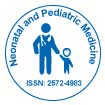当社グループは 3,000 以上の世界的なカンファレンスシリーズ 米国、ヨーロッパ、世界中で毎年イベントが開催されます。 1,000 のより科学的な学会からの支援を受けたアジア および 700 以上の オープン アクセスを発行ジャーナルには 50,000 人以上の著名人が掲載されており、科学者が編集委員として名高い
。オープンアクセスジャーナルはより多くの読者と引用を獲得
700 ジャーナル と 15,000,000 人の読者 各ジャーナルは 25,000 人以上の読者を獲得
インデックス付き
- Google スカラー
- レフシーク
- ハムダード大学
- エブスコ アリゾナ州
- ICMJE
役立つリンク
オープンアクセスジャーナル
このページをシェアする
抽象的な
Clinical Evaluation of Neonatal Malaria in a Sub-urban Healthcare Facility in South-East Nigeria
Lina Nwokeji-Onwe, Anthony N Ikefuna, Clifford O Okike, Obumneme B Ezeanosike, Kenechukwu K Iloh, Chidieb ere D Osuorah and Abraham B Onwe
Background: Malaria is a major killer in children under-5 years of age. Its incidence in neonates is commonly mis-diagnosed as sepsis and thus under-reported. Sometimes, a high index of suspicion for malaria in the neonate is necessary to make a diagnosis. Documentation of the clinical features of malaria in neonates and predictors of parasite density would aid in prompt diagnosis and management.
Objective: This study evaluated the clinical features of malaria in newborns in the first 28 days of life. It secondarily sought to determine factors that predict degree of malaria parasitemia in these newborns.
Methods: This longitudinal cross-sectional and descriptive study was conducted over a 7-month period. Four hundred and thirty neonates delivered and admitted in the Federal Teaching Hospital Abakaliki (FETHA) that met the inclusion criteria were consecutively enrolled after obtaining consent from their parent(s)/caregiver. Data on socio-demographics of the mother and neonates were obtained using the interviewer administered questionnaire. Blood samples were collected from neonates for malaria parasitemia using microscopy.
Results: Of the 430-newborn admitted during the study period, nineteen (4.4%) had neonatal malaria. Eighteen (94.7%) of these occurred within the first week of life. There was a cluster of malaria parasite density between 100-200 p/µl with a mean of 142.74 ± 70.96 p/µl. Neonates of mothers that received antimalarials during pregnancy [OR 1.556 (95% CI 0.318-7.608)], newborns of mothers with fever in pregnancy [OR 1.361 (95% CI 0.318-7.608)], newborns with birth weight ≥2.5 kg [OR 1.7 (95% CI=0.586-5.074)] and neonates within the first week of life [OR 3.319 (95% 0.394-27.982)] were more likely to have higher density of malaria parasitemia compared to newborns in the corresponding category. Malaria in surveyed neonates was noted to be mostly asymptomatic, but difficulty of breathing was the commonest symptomatic presentation among surveyed newborns.
Conclusion: Our study showed that malaria in neonates is mostly asymptomatic but could present as fever, breathing difficulty, yellowness of the eyes and lethargy. No specific clinical symptoms, maternal fever or use of anti-malaria in pregnancy, birth weight or post-natal age of neonates were significantly predictive of malaria parasite density in newborns.

 English
English  Spanish
Spanish  Chinese
Chinese  Russian
Russian  German
German  French
French  Portuguese
Portuguese  Hindi
Hindi